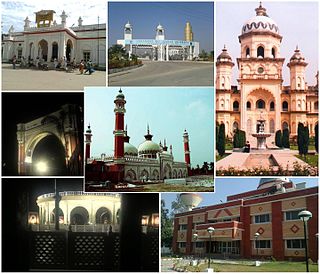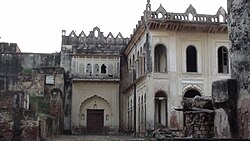
Rampur is a city, and the municipality headquarter of Rampur District in the Indian state of Uttar Pradesh. It was formerly known for its various industries, like sugar refining and cotton milling. Its library has more than 12,000 rare manuscripts and a fine collection of Mughal miniature paintings. It is located 322 kilometres north-west of the state capital Lucknow.

Rohillas are a community of Pashtun ancestry, historically found in Rohilkhand, a region in the state of Uttar Pradesh, India. It forms the largest Pashtun diaspora community in India, and has given its name to the Rohilkhand region. The Rohilla military chiefs settled in this region of northern India in the 1720s, the first of whom was Daud Khan.
The three Round Table Conferences of 1930–1932 were a series of peace conferences organized by the British Government and Indian political personalities to discuss constitutional reforms in India. These started in November 1930 and ended in December 1932. They were conducted as per the recommendation of Muhammad Ali Jinnah to Viceroy Lord Irwin and Prime Minister Ramsay MacDonald, and by the report submitted by the Simon Commission in May 1930. Demands for Swaraj or self-rule in India had been growing increasingly strong. B. R. Ambedkar, Jinnah, Sir Tej Bahadur Sapru, V. S. Srinivasa Sastri, Sir Muhammad Zafrulla Khan, K. T. Paul and Mirabehn were key participants from India. By the 1930s, many British politicians believed that India needed to move towards dominion status. However, there were significant disagreements between the Indian and the British political parties that the Conferences would not resolve. The key topic was about constitution and India which was mainly discussed in that conference. There were three Round Table Conferences from 1930 to 1932.

Bulandshahr, formerly Baran, is a city and a municipal board in Bulandshahr district in the state of Uttar Pradesh, India.

From a historical perspective, Professor Ishtiaq Ahmed of the University of Stockholm and Professor Shamsul Islam of the University of Delhi classified the Muslims of South Asia into two categories during the era of the Indian independence movement: nationalist Muslims and Muslim nationalists. The All India Azad Muslim Conference represented nationalist Muslims, while the All-India Muslim League represented the Muslim nationalists. One such popular debate was the Madani–Iqbal debate.
The Muslim Rajputs is an religious subgroup of Rajputs in the northern regions of the Indian subcontinent who are followers of Islam. They converted from Hinduism to Islam from the medieval period onwards, retaining Hindu surnames such as Rana and Chauhan. Today, Muslim Rajputs can be found in present-day Northern India and Pakistan. They are further divided into different clans.

Farrukhabad district is a district of Uttar Pradesh state in Northern India. The town of Fatehgarh is the district headquarters. The district is part of Kanpur Division.
Kaimganj is a town in Farrukhabad district in the Indian State of Uttar Pradesh. Kaimganj Railway Station is a major station between Farrukhabad and Kasganj on Rajputana railway link of North Eastern Railway.

Malihabad is a town and nagar panchayat in the Lucknow district of Uttar Pradesh, India. It is also the seat of a tehsil and a community development block of the same name. As of 2011, its population was 17,818, in 3,032 households. Malihabad is the largest of Uttar Pradesh's 14 designated mango belts and accounted for 12.5% of all mango production in the state in 2013. Hundreds of mango varieties are grown here, including the Chausa, Langda, Safeda, and most famously the Dasheri, the "king of mangoes", of which it is one of India's main producers and exporters. Mango grower and Padma Shri recipient Kaleem Ullah Khan has contributed to the popularization of Malihabad's mango industry.
Pahasu is a town and a nagar panchayat in Bulandshahr district in the Indian state of Uttar Pradesh.
Sherkot is a city and Municipal board in the Bijnor of the Indian state of Uttar Pradesh.

Lieutenant Colonel Saeed ul-Mulk Nawab Sir Muhammad Ahmad Said Khan, Nawab of Chhatari also generally referred to as Nawab of Chhatari was Governor of the United Provinces, Chief Minister of United Provinces, President of the Executive Council of the Nizam of Hyderabad and Chief Scout of India.
Major Nawab Sayyid Zulfikar Ali Khan Bahadur was an Indian politician and an Indian army officer who ruled as Titular Nawab of Rampur from 1982 to 1992, succeeding his elder brother Murtaza Ali Khan Bahadur.
Nawab Sayyid Muhammad Kazim Ali Khan Bahadur is an Indian politician and was a member of the 16th Legislative Assembly of Uttar Pradesh of India. Muhammad Kazim Ali served as an MLA in the Swar Tanda Uttar Pradesh state assembly; in 2003 he was briefly the state minister for Minority Welfare and Hajj Affairs. Since 2003, he has been the Chairman of the Uttar Pradesh Tourism Development Corporation.
The Lalkhani are a Muslim Rajput community, found in North India. They are a sub-division of the Bargujar clan of Rajputs, who converted to become Muslims. The community is found mainly in the districts of Aligarh, Hathras, Bulandshahr, Badaun. They are called Lalkhani Which does not apply to all Muslim Bargujar, as those originally from Haryana.

According to the 2011 census, West Bengal has over 24.6 million Muslims, making up 27% of the state's population. The vast majority of Muslims in West Bengal are ethnic native Bengali Muslims, numbering around over 22 million and comprising 24.1% of the state population. There also exists an Immigrants Urdu-speaking Muslim community numbering 2.6 million, constituting 2.9% of the state population and mostly resides in Urban areas of the state.
Nawab Abdul Samad Khan Bahadur (1861–1943) was the Nawab of Chhatari and Nawab of Talibnagar in the United Provinces of Agra and Oudh. He belonged to the Lalkhani family of Muslim Rajputs.

The Kheshgi, Khaishgi, Kheshagi, Khweshgi, or Kheshki is a prominent Sarbani Pashtun tribe and Imperial dynasty in South Asia.
The Aligarh Movement was the push to establish a modern system of Western–style scientific education for the Muslim population of British India, during the later decades of the 19th century. The movement's name derives from the fact that its core and origins lay in the city of Aligarh in Northern India and, in particular, with the foundation of the Muhammadan Anglo-Oriental College in 1875. The founder of the oriental college, and the other educational institutions that developed from it, was Sir Syed Ahmed Khan. He became the leading light of the wider Aligarh Movement.










